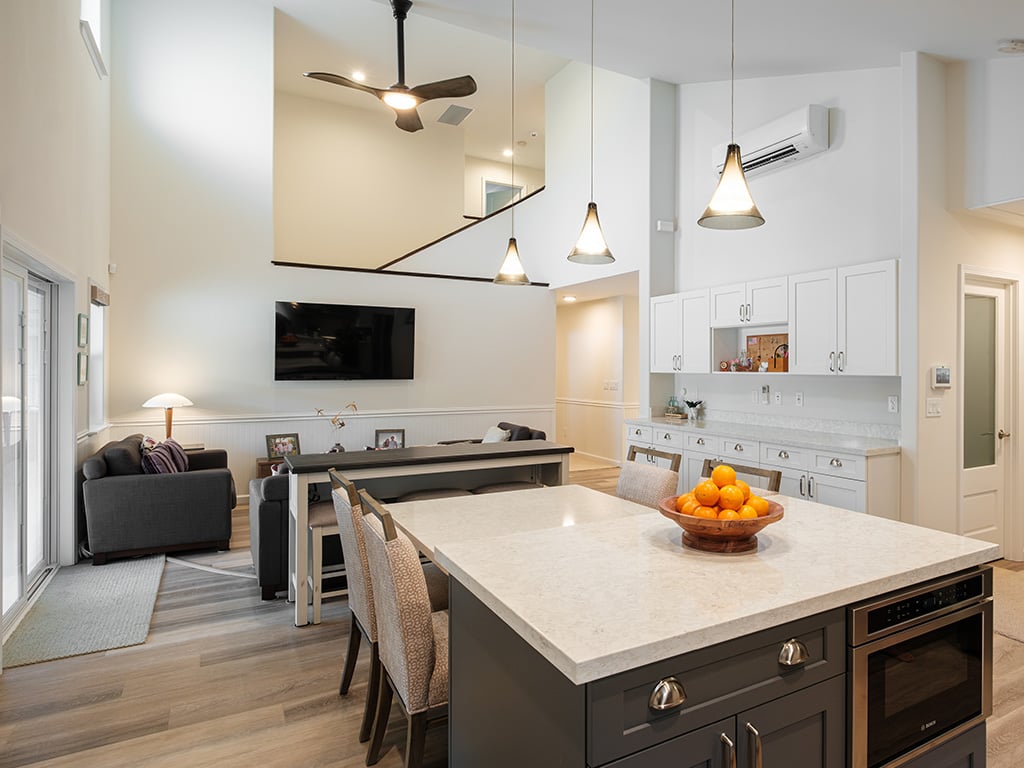Microgrid, Major Savings
Operating almost entirely off the grid.
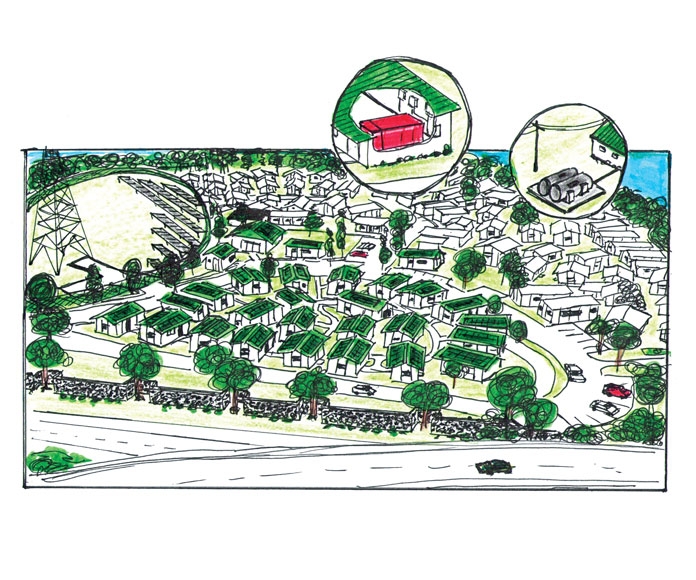
The creation of a microgrid and energy storage facility will allow Kahauiki Village to operate almost entirely off the grid.
PhotonWorks, a design-build general contractor with a focus on electrical- and energy-related projects and a passion for affordable and sustainable housing, worked closely with InSynergy Engineering on the microgrid design.
InSynergy Engineering analyzed how Kahauiki Village could be designed to be energy efficient, with the goal of reducing operating costs. “We did the conceptual evaluation of the alternatives and found this to be the preferred concept moving forward,” says Joel Yuen of InSynergy Engineering. “This is a small part in what Kahauiki Village stands for, but we’re hoping we can do our part to be cost effective and efficient to reduce the costs for each person living there.”
Working within the design of plantation-style roofs, PhotonWorks strategically placed photovoltaic panels on the roof planes to capture and produce energy. All of the residences share the energy collected, converted and stored in the system, so homes best oriented to capture sunlight have more panels than others.
The sunlight collected generates electricity, which is pushed to an energy storage facility, where the modular Tesla battery system is charged by the surplus electricity being generated. The energy storage facility then pushes the electricity back to the homes for energy consumption.
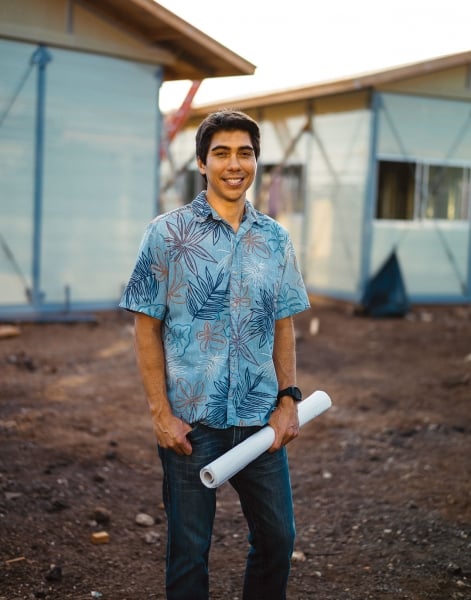
Photo: Aaron K. Yoshino
“We’re looking at 98 to 99 percent reliance on solar energy for the fully built out village, which is exceptionally high. It’s essentially an off-grid development with HECO and emergency backup generators combined providing 1 to 2 percent,” says Tim Johnsson of PhotonWorks. “While utilizing the sun to generate nearly all of the project’s electricity provides significant environmental and energy security benefits, they are only secondary to the primary design consideration: (ensuring the) lowest possible operating cost, which ultimately makes the project more affordable to more families.”
The system is designed to draw power from the battery to electrify the village’s homes and auxiliary buildings. During extended periods of insufficient sunlight, if the battery is not charged to the minimum level needed to electrify the village, power will be drawn directly from Hawaiian Electric to reduce the demand on the battery. Kahauiki Village’s connection to the grid is minimal in capacity to reduce standby and demand costs. Unlike conventional grid-tied PV systems where the grid alone can provide sufficient power under all conditions, the grid is capable of only supplementing Kahauiki Village’s energy needs. The liquid propane generators will be utilized exclusively to provide backup power in the case of equipment failure or during regular maintenance or repairs, Johnsson explains.
“Both centralized energy storage and emergency backup power is critical to the success of the project,” Johnsson says. “It helps reduce the high cost of requiring individual, autonomous energy storage and back-up infrastructure in each home and provides adequate redundancy to achieve a high level of reliability.”
The unique approach of designing a new community to operate off the grid is one that many hope can be replicated elsewhere.
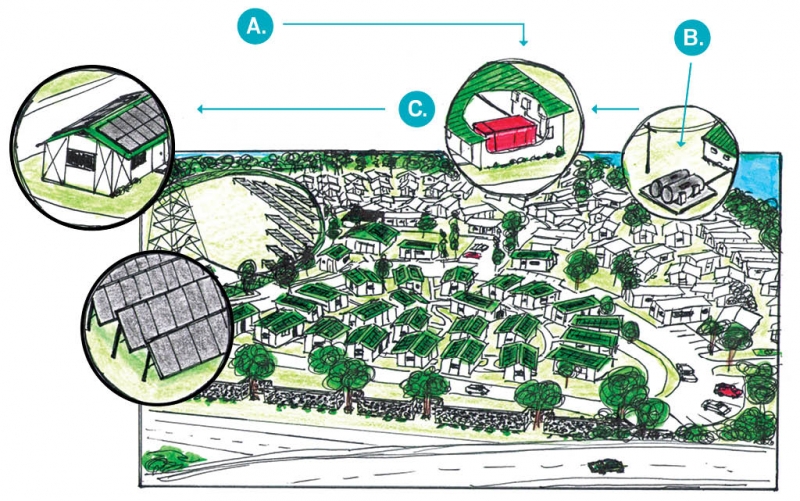
B. Grid electricity is provided when there are consecutive days of insufficient sunlight; on-site propane generator provides power during microgrid maintenance or an emergency.
C. Each night and during cloudy conditions, the storage battery releases the stored energy back to the homes.
Illustration: Photonworks
“While utilizing the sun to generate nearly all of the project’s
electricity provides significant environmental and energy security benefits, they are only secondary to the primary design
consideration: (ensuring the) lowest possible operating cost, which ultimately makes the project more affordable to more families.”
— Tim Johnsson, PhotonWorks
A Home To Be Proud Of
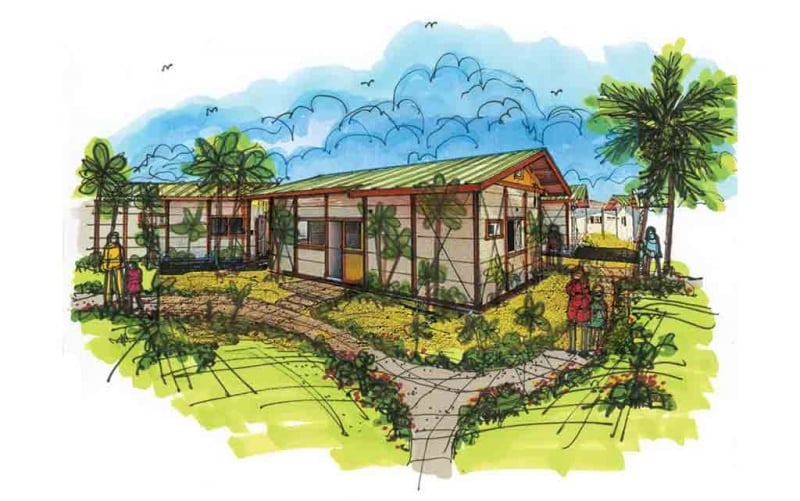
Japanese industrial company Komatsu built the prefabricated houses as emergency homes for tsunami victims in Tohoku, Japan, and Kahauiki Village organizer and architect Lloyd Sueda designed embellishments to give the homes a look more similar to those of Hawaii’s plantation communities.
“I’m trying to make it look like more than housing,” Sueda says. “I want them to have pride in what they’ll be renting, so we’re putting these extra [details] in.”
HPM Building Supply donated the roofs not only for the homes, but also the auxiliary buildings within Kahauiki Village. APEX donated labor to cut and build the roof trusses.
Sueda selected a metal roof, a material used for plantation home roofs, and colors. HPM Building Supply then manufactured and delivered the custom roofs and systems. Michael Fujimoto of HPM Building Supply explains the contemporary design of the galvanized steel roofs allow for the installation of solar panels on the ribs of the standing seam.
Fujimoto’s great-grandfather, a skilled carpenter and later general contractor, built many residences, including plantation homes, before founding the company 96 years ago. “Much of our existence has been providing shelter in different forms to different communities on the Big Island, Oahu and Kauai. Kahauiki Village is one of those projects that can really tug at your heart,” Fujimoto says. “The company has always had a strong feeling of responsibility for bettering our community and this gives us another way to contribute toward our mission.”



